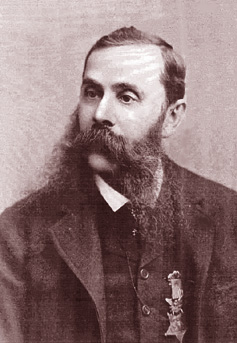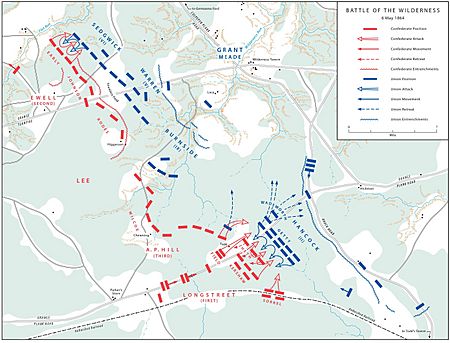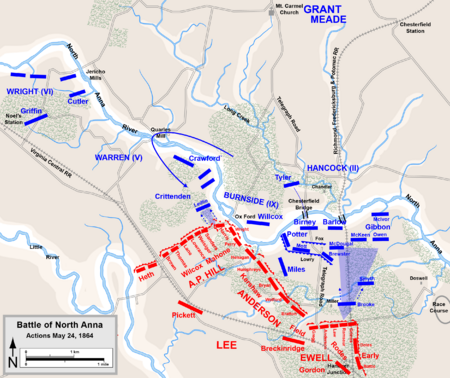Leopold Karpeles facts for kids
Quick facts for kids
Leopold Karpeles
|
|
|---|---|
 |
|
| Born | 9 September 1838 Prague, Bohemia |
| Died | 2 February 1909 (aged 70) |
| Place of burial | |
| Allegiance | United States of America Union |
| Service/ |
United States Army Union Army |
| Years of service | 1862–1863, 1864–1865 |
| Rank | Color Sergeant |
| Unit | 46th Massachusetts Infantry 57th Massachusetts Infantry |
| Battles/wars | Battle of the Wilderness Battle of North Anna |
| Awards | Medal of Honor |
Leopold Karpeles (born September 9, 1838 – died February 2, 1909) was a brave flag bearer in the Union Army during the American Civil War. He earned the Medal of Honor, which is the highest military award, for his amazing courage.
Leopold was born in Prague (which is now in the Czech Republic). When he was young, he moved to Texas in the United States. There, he worked protecting groups of people traveling across the American frontier. He strongly believed that slavery was wrong. Before the war started in 1861, he even helped the Underground Railroad, a secret network that helped enslaved people escape to freedom.
When the war began, Karpeles joined the Union Army. He carried the special flag, called a battle standard, for the 46th Massachusetts Volunteer Infantry Regiment. Later, he joined the 57th Massachusetts Volunteer Infantry Regiment. During a very tough fight called the Battle of the Wilderness, his unit lost many soldiers. But Karpeles stayed strong, holding his ground and inspiring others to keep fighting. He was wounded later in the war, which led to him leaving the military. He spent the rest of his life in Washington, D.C., working in business and later for the government.
Contents
Early Life and Beliefs
Leopold Karpeles was born in Prague into a well-known and wealthy Jewish family. He moved to Galveston, Texas, when he was 11 years old. He was very smart and learned to speak many languages, including English, French, German, Greek, and Czech. In Texas, he also became skilled with weapons like knives, lassos, rifles, pistols, and sabers.
Leopold found his school and store work boring. He preferred adventure, so he volunteered to join supply convoys that shipped goods around Texas. He helped defend these convoys from attacks. He even sometimes joined the Texas Rangers. This work made him happy because he loved being outdoors and felt a sense of adventure.
Karpeles strongly disliked violence against women and children, and he especially hated slavery. He is believed to have helped the Underground Railroad. He helped enslaved people escape to safety with Mexican and Seminole friends.
When Texas decided to leave the Union in 1861, Leopold moved to Springfield, Massachusetts. He found a job as a shop clerk. There, he made friends with people who wanted to end slavery, known as abolitionists. He continued to help the Underground Railroad, which was less dangerous in Massachusetts than in Texas.
Joining the Union Army
Leopold Karpeles was inspired by other abolitionists. He joined the 46th Massachusetts Volunteer Infantry Regiment in September 1862. Because of his past experience, he was quickly promoted to corporal. He then volunteered for a very important and dangerous job: being a standard bearer. This meant he would carry the unit's flag into battle without a weapon. It was a great honor.
Karpeles served bravely in several battles in North Carolina in late 1862. His commander, W. S. Shurtless, wrote about his courage. He said Karpeles was quick to join the fight and stood firm, even when bullets hit his flag many times. Karpeles later wrote that being a flag bearer was "inspiring." He also said that a soldier's life was hard, trying to stay strong despite terrible conditions.
After his first term ended in July 1863, Karpeles decided to rejoin the army. He joined the 57th Massachusetts Volunteer Infantry Regiment in late 1863. This unit was made up of experienced soldiers. Karpeles was promoted to sergeant and was likely the only Jewish soldier in his unit. Again, he asked to carry the flag. He was named the regiment's color sergeant, which meant he was in charge of the flag. His unit marched to Washington, D.C., and he proudly saw President Abraham Lincoln during a parade.
Medal of Honor Action
In May 1864, Karpeles's unit joined Ulysses S. Grant's army during the Overland Campaign. They arrived near Spotsylvania County, Virginia, just as the Battle of the Wilderness was starting. The fighting was brutal, with thick smoke and difficult terrain. Karpeles's regiment, the 57th, was in the front lines. They suffered huge losses, with nearly half of their 548 men becoming casualties. They had more casualties than any other regiment in that battle.
During the battle, the Union's right side began to fall apart. Other regiments started to run away in a panic. Karpeles bravely stood on a tree stump, holding his flag high. He called out to the retreating soldiers, telling them to stop and fight. His courage was seen by high-ranking officers. About 34 men from his regiment, and even soldiers from other units, rallied around Karpeles.
He later described what happened: "We succeeded in forming these men into a fighting line... and by a rapid discharge of firearms managed to check the enemy." This small group held their ground until sunset. Karpeles's actions were so heroic that he was awarded the Medal of Honor on April 29, 1870. He was the first Jewish person to receive this award.
Later Military Service
After the Battle of the Wilderness, the 57th Regiment moved on to the Battle of Spotsylvania Court House. They fought bravely, even using bayonet charges to scare the Confederate troops. The fighting was slow and difficult.
Their next major battle was the Battle of North Anna on May 24. During a poorly planned attack, the 57th Regiment charged across open ground. They were almost completely wiped out. Karpeles was wounded in the leg and fell. But he got back up to keep fighting until his commander took the flag from him. He had lost too much blood to continue. Other soldiers helped him back to safety. After this terrible charge, only 199 men in his regiment were left to fight. Karpeles was unconscious for several days and could not return to combat until October.
He rejoined his unit during the siege of Petersburg and fought in the Battle of Poplar Springs Church and the Battle of Vaughan Road. However, his leg wound reopened and became worse. He collapsed during a raid on December 20, 1864, which ended his military service. He is known as one of the longest-serving flag bearers of the war who was not permanently crippled.
Life After the War
Karpeles was taken to a hospital in Washington, D.C., for his leg. Doctors thought they might have to cut off his leg. But a 16-year-old volunteer named Sara Mundheim convinced them to let her family care for him at home. His leg was saved, and he recovered through the end of the war. After the war, Leopold and Sara got married. They had a daughter named Theresa.
The family opened a hat shop in Washington, D.C. Leopold managed sales and finances, while Sara made the hats. Sadly, Sara died in 1872 while giving birth to their third child. On her deathbed, she asked Leopold to marry her sister, Henrietta. Leopold's second and third children from his first marriage died young. But he and Henrietta had three sons and three daughters.
Leopold Karpeles became an important part of Washington society. He was a popular speaker at political events and veteran gatherings. In 1875, he started working as a clerk for the United States Department of the Treasury. He was known for spending his money on parties for friends and helping those in need. He knew many lawmakers and diplomats, including Presidents Chester A. Arthur, Grant, and William McKinley.
He used his connections to support workers' rights, like asking for shorter workdays. He also joined a veterans' group called the Grand Army of the Republic. He helped advocate for Memorial Day, a day to honor fallen soldiers. He also helped start the Medal of Honor Legion. This group worked to make sure the Medal of Honor was given only for true bravery in combat, not for political reasons. When the Spanish–American War started in 1898, Karpeles wanted to rejoin the military. But he was too old, and his wartime leg injury caused him to limp, so he couldn't go back.
Leopold Karpeles died in 1909. He was buried in the cemetery of the Washington Hebrew Congregation. His gravestone has the Medal of Honor emblem on it. Sadly, his actual medal was later lost in a fire.
See also



